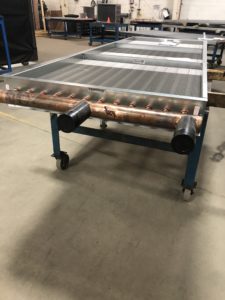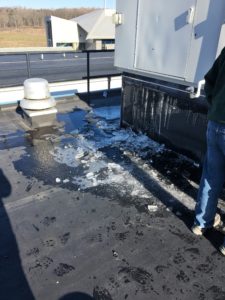 Were you aware that Steam Distributing coils or “Non-Freeze” steam coils were essentially discovered by accident? First, it must be mentioned that there is no such thing as a 100% “Non-Freeze” steam coil because under the right conditions, any coil can freeze. As such, Capital Coil tries to steer clear of the term “Non-Freeze” because it is a mischaracterization. Steam Distributing Coils is the correct terminology that Capital Coil uses when speaking about steam coils that see entering air temperatures under 32* F. Trapped condensate in the tubes and/or headers, coupled with entering air temperatures below 32*F over the face of the coil, creates a situation with a near-100% certainty that your steam coil will freeze. Because of this, there is no magical solution to fully eliminate freezing your coil, which again is why Capital Coil does not use the term “Non-Freeze”.
Were you aware that Steam Distributing coils or “Non-Freeze” steam coils were essentially discovered by accident? First, it must be mentioned that there is no such thing as a 100% “Non-Freeze” steam coil because under the right conditions, any coil can freeze. As such, Capital Coil tries to steer clear of the term “Non-Freeze” because it is a mischaracterization. Steam Distributing Coils is the correct terminology that Capital Coil uses when speaking about steam coils that see entering air temperatures under 32* F. Trapped condensate in the tubes and/or headers, coupled with entering air temperatures below 32*F over the face of the coil, creates a situation with a near-100% certainty that your steam coil will freeze. Because of this, there is no magical solution to fully eliminate freezing your coil, which again is why Capital Coil does not use the term “Non-Freeze”.
Steam turns to condensate little by little as it travels through the coil. Lower pressure steam turns to condensate faster than higher pressure steam!! The longer the tube length in the coil, the earlier the condensate is formed, and the longer it has to travel through the tubes. One very important fact to always remember is that too much condensate in a steam coil IS NEVER A GOOD THING…under any circumstances! Because of this requirement, everything is designed to ensure the removal of all condensate from the coil. Systems are heavily designed with float & thermostatic traps, vacuum breakers, and placement of piping to help get rid of any remaining condensate.
Another headache that occurs when condensate freezes is that it creates a “water-hammer”. A “water-hammer” can best be described as a loud banging noise as the steam is coming into contact with the condensate in the coil. It does not allow the steam to be evenly distributed across the face of the coil…again not a good thing!
At the inception of the HVAC industry, steam coils were originally designed to be shorter in length because there was not a good way to evacuate condensate. In an effort to make steam coils longer in length, the concept of a steam coil containing a tube within a tube was invented. The steam feeds only the inner tubes, which travels the entire of the length of the outer-tube. Holes are placed every 12” with the inner tube releasing condensate to the outer-tube. The idea is that the condensate is slowly and evenly “distributed” across the entire length of the coil. Heating is also evenly applied across the coil’s face, and if the casing is pitched at a downward angle, condensate cannot remain trapped. It was later discovered as an added bonus that under most circumstances these coils will not freeze. So while the concept was never designed or intended to become known as “Non-Freeze”, they are now used in almost all projects dealing with air temperatures below 32*F. Please keep in mind that you will still need all of the other steam protective devices in the system, including the freeze-stat, but all in all, it is much more difficult to freeze coils today than it was 30-40 years ago. Necessity may be “the mother of invention” but this great concept was discovered accidently.
Capital Coil is available for all of your coil-related trivia needs, so please don’t hesitate to reach out whenever we can be of assistance.
RELATED POSTS
Frozen Steam Coils: How Do You Prevent This?
CATEGORY SUCCESS
